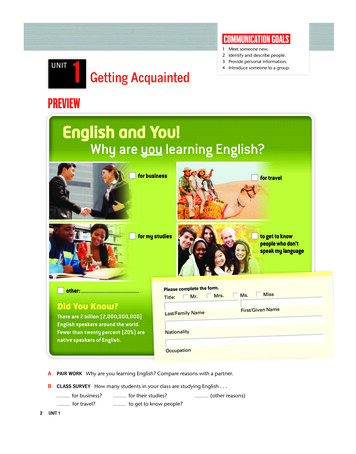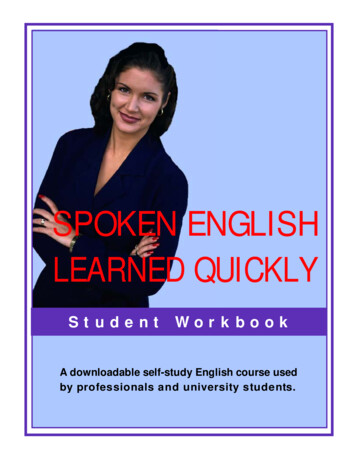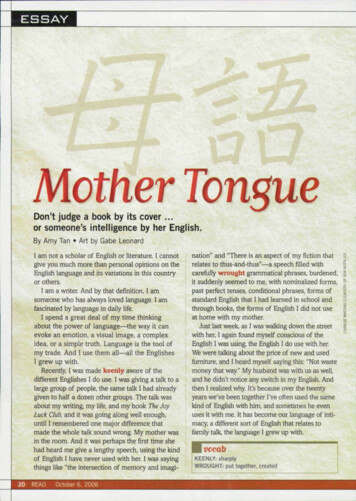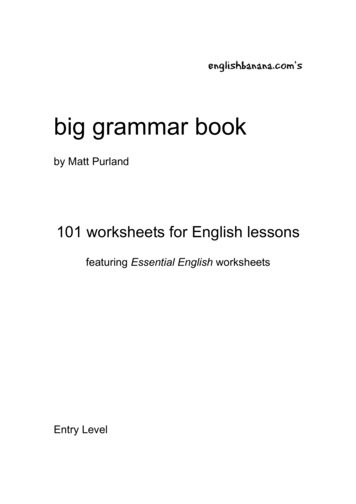
Transcription
communication goalsUNIT11234Meet someone new.Identify and describe people.Provide personal information.Introduce someone to a group.Getting AcquaintedpreviewEnglish and You!Why are you learning English?for businessfforor traveltraavellforo my studiesttoo gget to knowppeopleeoople who don’tsspeakpeeak my languagePl e a s e c o m p l e t e t h e f o r m .Mrs.Mr.Title:otheroother:th e r :DidDid YYoYouou KKnow?now?ThereTThhere aarere 2 bbillionrebilliillion )00)EEnglishnglliish sspeakerspeaakerskers aaroundarounround tththehe wworld.worldorlldd.FFewerewer tthanewhan ttwentywentywenty ppercentpercenercent ((20%)20%) aarererennativeative sspeakersppeakerseakkeers ooff EEnglishEnglish.nglliish.Ms.MissFirst/Given NameLast/Family NameNationalityOccupationA PAIR WORK Why are you learning English? Compare reasons with a partner.B CLASS SURVEY How many students in your class are studying English . . .2for business?for their studies?for travel?to get to know people?(other reasons)UNIT 1M01 TOPN TE 01 0516 U01.indd 210/7/14 9:00 AM
UNIT1Getting AcquaintedB Class sur veypreviewSuggestedteaching time:Before Exercise A, give students a few minutes of silenttime to observe the questionnaire and personalinformation form.Your actualteaching time: Ask How many of you are studying English for business?How many are studying English for travel? etc. Tell studentsto raise their hands when they hear the reason(s) theychecked. Write the names of students under each reason. Circle the most popular reason and discuss; for example,ask Where do you want to travel? or What do you study?Elicit short answers. If students have difficulty, askyes/no questions (D o you want to travel to Paris? D o youstudy computers?) and have students say Yes or N o.Langu age and cu ltu reFYI: Language and culture notes are provided to offerstudents enrichment or more information about languageand/or culture. Their use is optional. Forms generally ask for a person’s family name first andgiven name second because family names are used tokeep records. However, we always refer to the family nameas the last name and the given name as the first name. In many Asian countries, the family name comes first, butit is still referred to in English as the person’s last name.10–15minutesA Pair workSuggestedteaching time:10minutesYour actualteaching time: To model this activity, write your full name, including atitle, on the board; for example, M s. Susan M iller (Hereand throughout, substitute real names and informationfor examples provided.) Label and talk about each part of your name: [Susan] ismy first name. My parents chose that name. [Miller] is myfamily name. Everyone in my family and my father’s familyhas the name Miller. Tell the class where you are from and what you do; forexample, I am from Australia. I am a teacher. Then writeon the board: Have students fill in the chart with their own information.Tell students who don’t work to write student as theiroccupation on the form. Point out the Did You Know? fact next to the form. Writethe number 2 billion on the board (2,000,000,000).Then ask How many students are there in this class? Addthe number of students to the large number on theboard. For example: 2,000,000,025. Read each reason for studying English aloud. For the fifthoption, other reasons, brainstorm ideas from students andwrite them on the board. For example:N ationality:A ustralianO ccupation:TeacherPeople speak English everyw here.I like English music.It’s a beautiful language.I w ant to visit my sister in N ew York C ity. Have students compare their answers in pairs.FYI: Some students will want to give more than one reasonfor studying English. Let them check two or three reasonsand then circle their number 1 reason for studying English.UNIT 1, PREVIEWM01 TOPN TE 01 0516 U01.indd T2T210/7/14 9:00 AM
FYI: All recorded material is indicated with the following Write your title with your first name and your title withyour last name on the board. Ask Which is correct? Thencross out your title with your first name. Make surestudents understand that a title is used with a full name(first and last name) or with just the family (last) name,but never with just the first name. Ask Are you a man or a woman? Are you married or single?Have students determine which title to use with theirfamily names. Female students will have a choice of titles(see the language and culture note below).icon 0:00 . CD track numbers for all recorded materialappear in this icon. For example, 1:02 indicates that therecording is located on CD 1, track 2.C1:02Ph oto storySuggestedteaching time: 10minutesYour actualteaching time:To warm up, ask:How many people are in the photos? (Four.)How many are men? (Two.)How many are women? (Two.)After students read and listen to the conversation, checkcomprehension. Ask:In the first photo, what’s the man’s name? (Samuel Pike.)What’s his first (or given) name? (Samuel.)What’s his last (or family) name? (Pike.)What is Cara’s friend’s name? (Susan Grant.)What’s her nickname? (Suzy.)What’s her occupation? (Photographer.)Is Suzy married or single? (Married.)What’s her husband’s first name? (Ted.)Langu age and cu ltu re A nickname is a shorter form of someone’s real name,usually given by friends or family. From the Longman Corpus: G ood to meet you and Pleasedto meet you are also common ways to greet someone, butN ice to meet you is by far the most frequent of the three inspoken American English.D Focu s on langu ageSuggestedteaching time:5–10minutesTo make sure the class understands the word informal, sayTed calls Samuel Pike “Mr. Pike.” Mr. Pike says “Please callme Sam.” He wants to be informal. Have students identify the underlined expressions in thePhoto Story by taking turns reading them aloud. After students find the answers with a partner, reviewwith the class. Write the answers on the board sostudents see a list of the key expressions in this dialogue.For example:IntroducingPeopleI’d like you tomeet .This is .1:03T3Your actualteaching time: Option: ( 5 minutes) Explain other titles students may comeacross. (D r. [doctor], Prof. [professor], etc.)GreetingNew PeopleIt ’s a pleasureto meet you.Great to meetyou.H ow nice tomeet you.Being Informalwith PeopleEveryone callsme .Just call me .Please call me.Formal titlesMake sure students understand the difference inpronunciation between Ms. (/miz/) and Miss (/mis/).Langu age and cu ltu re In some English-speaking countries, some womenprefer the title Ms. because it does not draw attention towhether they are married or single. Use Ms. when youdon’t know which title she prefers. When meeting someone for the first time, you should usea title and last name if the person is older or if you are in aprofessional / formal situation.SPEAKINGA Complete your response . . .Suggestedteaching time:2–3minutesYour actualteaching time: Before students complete the exercise, read the lines inthe speech balloons aloud to the class. To review, have volunteer pairs read the completedexchanges aloud.Option: ( 5 minutes) For further practice, have all thestudents write their names in large print on a folded pieceof paper and place it in front of them so other studentscan read it. On the board, refer to the phrases in the BeingInformal with People column in the chart from Exercise D.Then walk around the classroom and introduce severalstudents. Use the student’s title and family name. Say C lass,this is Mr. / Ms. / Mrs. / Miss [family name]. Prompt thestudent to reply with one of the phrases and his or her owninformation (Just call me [first name or nickname]).B R ole p laySuggestedteaching time:8–12minutesYour actualteaching time: Have students brainstorm the names of famous people.Write their ideas on the board. Have the class respond to each introduction with oneof the phrases from the Photo Story. You can refer themto the phrases in the G reeting N ew People column in thechart from Exercise D.extrasWorkbookUNIT 1, PREVIEWM01 TOPN TE 01 0516 U01.indd T310/7/14 9:00 AM
C1:02PHOTO STORY Read and listen to people getting acquainted.Susan: I’ll bet this is your dad.Cara: Yes, it is. Dad, I’d like you tomeet my friend, Susan Grant.Sam: It’s a pleasure to meet you,Susan. Samuel Pike.Susan: Great to meet you, too. Butplease, everyone calls me by mynickname, Suzy.Sam: And just call me Sam. So, whatdo you do, Suzy?Susan: I’m a photographer . . . Oh,I’m sorry. There’s my husband . . .Ted, over here!D FOCUS ON LANGUAGE Look at the underlined expressions in theTed: Sorry I’m late.Susan: Ted, this is Cara’s dad.Ted: Oh, how nice to meet you,Mr. Pike!Sam: Likewise. But please call meSam.Formal titlesWomenMs. (married or single)Mrs. (married)Miss (single)Use titles with family names,not given names.Ms. Grant NOT Ms. SuzyMarital statusmarried single 1:03MenMr.Photo Story. With a partner, find:1 two ways to introduce people. I’d like you to meet / This is2 three ways to greet new people. It’s a pleasure to meet you / Great to meetyou / How nice to meet you3 three ways to tell others they can be informal.Everyone calls me / Just call me / Please call meSPEAKINGA Complete your response to each person. Write the correct formal titles.Nice to meet you.GIVEN NAMEFAMILY NAMEOCCUPATION1MarcAnthonysingerGood to meet you, too, Mr. Anthony !(Mr. Marc / Mr. Anthony / Ms. Anthony)B ROLE PLAY Imagine your partner is a famous person.Introduce your partner to the class. Use formal titles.M01 TOPN TE 01 0516 U01.indd 3Good to meet you.JenniferFAMILY NAME LawrenceOCCUPATION actorGIVEN NAMEMs. LawrenceNice to meet you, too,!(Ms. Lawrence / Ms. Jennifer / Mr. Lawrence)2“I’d like you to meet Bradley Cooper.Mr. Cooper is an actor.”UNIT 1310/7/14 9:00 AM
LESSON1goalMeet someone newCONVERSATION MODELA1:04 Read and listen to peoplemeeting someone new.A: Who’s that?B: Over there? I think she’s new.A: Well, let’s say hello.B: Good morning. I’m Alex,and this is Lauren.C: Hi. My name’s Kathryn Gao.But everyone calls me Kate.A: Great to meet you, Kate.Where are you from?C: New York.BRHYTHM AND INTONATIONListen again and repeat. Thenpractice the ConversationModel with a partner.1:05GRAMMAR Information questions with be: ReviewWho’s Ms. Nieto?Who are they?Where’s she from?What city are you from?What’s your occupation?What’s his e-mail address?What are their names?How old is your brother?How old are they?She’s my teacher.Who’s Who isWhere’s Where isThey’re my classmates.What’s What isShe’s from Seoul, Korea.We’re from Los Angeles.I’m an engineer.It’s ted@kr.com [say “ted at k-r-dot-com”].Andrea and Steven.He’s twenty-six.She’s twelve, and her little sister is eight.ContractionsI’m I amhe’s he isshe’s she isit’s it isyou’re you arewe’re we arethey’re they areGRAMMAR BOOSTER p. 123 Information questions with be:usage and form Possessive nouns and adjectivesA GRAMMAR PRACTICE Complete the conversations. Use contractions ofthe verb be when possible.Who’s1 A:that over there?She’sB: Oh, that’s Hasna.from Lebanon.HowoldisA:she? She looks very young.she’sB: I thinktwenty-five.42 A: Your new neighbor’s good-looking!What’shis name?B: His name’s Francisco.Where’sA:he from?B: El Salvador.UNIT 1M01 TOPN TE 01 0516 U01.indd 410/7/14 9:00 AM
LESSON1CONVERSATION MODELA 1:04 Read and listen . . .Suggestedteaching time:2minutesYour actualteaching time:These conversation strategies are implicit in the model: Begin responses with a question to confirm. Use Let’s to suggest a course of action. Ask personal questions to indicate friendliness. To make sure students understand that and over there,indicate different students who are sitting far away fromyou. Ask the class Who’s that? To clarify, gesture toward astudent and say Over there. Point out that Alex and Kathryn introduce themselves.They say “I’m Alex” and “My name’s Kathryn Gao.” Tointroduce a third person, Alex says “This is Lauren.” After students read and listen, ask them to underlinethe names. (Alex, Lauren, Kate) Then have students readagain and label the people in the photo. For comprehension, ask yes / no questions:Is she Lauren? [point to the woman in the red shirt] (No.)Is he Alex? [point to the man standing] (Yes.)Is Lauren from N ew York? (No.)Is Kate from N ew York? (Yes.)B1:05Langu age and cu ltu re There is a special vocabulary for saying e-mailaddresses: @ is at; the period is called dot. For example, forthe e-mail address Mary21@skyline.com, you say “Marytwenty-one at skyline dot com.” From the Longman Corpus: In spoken American English,the contractions who’s, what’s, where’s, and that’s are usedmore than seven times as often as who is, what is, where is,and that is.Rhythm and intonationSuggestedteaching time: Option: ( 5 minutes) To contrast ’s in these contractions withthose used in possessives, review possessive nouns andpossessive adjectives. (A review of possessive nouns andadjectives can be found in the Grammar Booster on p. 123.) Pick up a student’s book and say [Jenna]’s book. Thenwrite on the board: [Jenna]’s book. Walk around the room, picking up items from differentstudents’ desks. Have the class use the possessive to tellyou whom the item belongs to. Have students look at where you wrote [Jenna]’s bookon the board. Cross out the possessive noun and writehis or her in its place. Repeat some of the possessive nouns used previouslyto identify students’ belongings. Elicit possessiveadjectives in their place; for example, say [Michael]’sbook and elicit his book from the class. Pick up an item belonging to you. Say the teacher’s[book]. Elicit your book from the class. Say the students’classroom and elicit our classroom. Point out that for separate possessions, add ’s to eachname; for example, Those are John’s and Tina’s cars.When there is only one possession belonging to two ormore people, the ’s only goes with the second or lastperson. This is Marie and Robert’s house.2minutesYour actualteaching time:Have students repeat each line chorally. Make surestudents:use falling intonation in Who’s that? and risingintonation in Over there?pause after Well.Option: GRAMMAR BOOSTER (Teaching notes p. T123)Inductive Grammar ChartsGRAMMARSuggestedteaching time: 7–10minutesYour actualteaching time:Review the examples. Practice the meanings of Who,What, Where, and How old. Call out a person, thing, place,or age. The class responds with the appropriate questionword; for example, call out Kate and the class respondsWho. For What, you can call out a name, title, nationality,or occupation.A Gr ammar p racticeSuggestedteaching time: 4–6minutesYour actualteaching time:Have students check their answers with a partner. Thenreview as a class. For each item, have different studentsread the roles of A and B.Extra Grammar ExercisesUNIT 1, LESSON 1M01 TOPN TE 01 0516 U01.indd T4T410/7/14 9:00 AM
B Gr ammar p racticeSuggestedteaching time:3–5minutesYour actualteaching time: Review question words from page 4 with students. Remind students that they can begin their questions withwords from the “ Ideas” box. Have students practice the conversation, switching rolesso that students have the chance to play A, B, and C. To enable students to move around the room moreeasily, you may want to have the class stand to introducethemselves to someone new. G ive students a few minutes to skim the word posts(language in the Recycle box). For more information onwordposting, see the Actively D eveloping Free Expressionsection of the Introduction. Encourage students to useall the language in the Recycle box. Have them checko each question or phrase as they use it. Point out thatstudents can also use the language for self-introductions:I’m [Tania] and My name is [Tania].Langu age and cu ltu re In some cultures, asking a person’s age is consideredimpolite. It’s typically O K to ask a child or young personHow old are you?C Pair workSuggestedteaching time: don’t stop! Extend the conversation. Encourage students3–5minutesto ask their partners at least one of the questions fromthe D on’t Stop! box.Your actualteaching time:To model the activity, have volunteers ask youinformation questions with be. Write a few of thequestions on the board and then answer with completesentences. Your students might ask:Who are your friends?What’s your e-mail address?Where are you from?How old are you?Option: ( 5 minutes) To help students ask more questionswith Who, introduce or review the word favorite. Studentscan ask Who’s your favorite teacher / singer / actor / athlete /artist? For more support, play the Conversation Activator V ideobefore students do this activity themselves. In Scene 1,the actors use di erent words in the gaps from the onesin the Conversation M odel. In Scene 2, the actors extendthe conversation. After each scene, ask students to sayhow the model has been changed by the actors.Conversation Activator Video Script; ConversationActivator Pair Work Cards; Learning StrategiesB Chang e p artnersSuggestedteaching time: now y ou can M eet someone newA Conversation activatorSuggestedteaching time:12–15minutesYour actualteaching time:Conversation Activator VideoT5 N ote: You can print the script or you can show a runningtranscript on the video player on the ActiveTeach. Thescript also appears on page 179 of this Teacher’s Edition. M odel the conversation with a student. Play the role of B.Act out the conversation. Take the student playing therole of A over to meet the classmate he or she indicates. Be sure to reinforce the use of the conversation strategies;for example, have students ask personal questions toindicate friendliness. Ask the class for ideas about how tocontinue the conversation; for example, students can askWhat city are you from? What’s your occupation?12–15minutesYour actualteaching time:M ake sure students switch roles when they changepartners so they practice all parts of the conversation.extrasWorkbook or M yEnglishLabSpeaking Activities: Unit 1, Activity 1UNIT 1, LESSON 1M01 TOPN TE 01 0516 U01.indd T510/25/14 7:42 AM
DIGITALMOREEXERCISESWho are3 A:they?they’reB: I thinknew students.What areA:their names?B: Evan and Kim.5 A: I’ll call you sometime.phone number?It’sB:555-0296.A: 555-8747.4 A: It was nice to meet your brothers.How old arethey?B: Greg’s only fourteen. But my older brother,David, is twenty-eight.What’sA:David’s occupation?He’sB:a lawyer.6 A:What’syourWhat’syours?What’syour e-mail address?I’ll send you a note.It’schoi23@kr.com.B:A: K - r - dot - com? That’s interesting.ng.Where areyou from?B: Busan, Korea. I’m hereere on business.buB GRAMMAR PRACTICE Write at least four information questions for your partner.Begin each question with a capital letter and end with a question mark.Answers will vary, but may include the following:What’s your phone number?Where are you from?IdeasWho . . . ?What . . . ?Where . . . ?How old . . . ?erMillrey93Aud38555(415)cell:il: pnet.comameym@audreHow old are you?What’s your last name?What’s your occupation?C PAIR WORK Now ask your questions, and answer your partner’s questions.now you canDIGITALVIDEOMeet someone newA CONVERSATION ACTIVATOR With two partners, personalize theConversation Model. Imagine one of you is new to your school,office, or neighborhood. Meet that person. Then change roles.A: Who?B: Over there? I thinkA: Well, let’s say hello.B:C:A:C:new. I’m, and this is. My name’s. Where are you from?.don't stop!Ask more questions.What city are you from?What’s your occupation?Who’s your teacher?RECYCLE THIS LANGUAGE.Introduce peopleThis is .I’d like you to meet .Greet new peopleGreat to meet you.How nice to meet you!It’s a pleasure to meet you.Shift to informalityEveryone calls me .Please call me .Just call me .B CHANGE PARTNERS Practice the conversation again.Meet other people.WelcomeUNIT 15M01 TOPN TE 01 0516 U01.indd 5510/7/14 9:00 AM
LESSON2goalIdentify and describe peopleGRAMMAR Modification with adjectives: ReviewAdjectives describe nouns and pronouns. They can go after the verb be or before a noun.Usain Bolt is terrific. He’s a terrific athlete from Jamaica.Tony Leung and Gong Li are famous. They’re famous actors from China. They’rewonderful.Use an article before an adjective that modifies a singular noun.He’s a great musician. NOT He’s great musician.1:06 Positive wonderfulgreatA GRAMMAR PRACTICE Combine each pair of sentences.1 Chris Pine is an actor from the U.S. He’s handsome.Ch ris P ine is a hands om e actor from the U .S .2 Emeli Sandé is a singer from the U.K. She’s fantastic.Chris Pine is a handsome actor from the U.S.Em eli S andØ is a fantastic singer from the U .K .3 Cheng Fei and Yao Jinnan are athletes from China.They’re terrific.Ch eng Fei and Yao Jin nan are terrific athletes from Ch ina.4 Sebastião Salgado is a photographer from Brazil.He’s great.S ebastiª o S algado is a great photographer from B raz il.5 Alice Munro is a writer from Canada. She’s famous.Alice Mu nro is a fam ou s wr iter from Ca nada.DIGITALMOREEXERCISESB Now write three sentences about other famous people.Use an adjective before a noun.CONVERSATION MODELARead and listen to someone identifyyand describe a person.1:07A: Hey. Who’s Lucia Micarelli?B: You don’t know? For real?A: No. Is she famous?B: She sure is. She’s a great musician.A: Where’s she from?B: The United States.B1:08 RHYTHM AND INTONATION Listenagain and repeat. Then practice theConversation Model with a partner.GRAMMAR Yes / no questions and short answers with be: ReviewAre you our teacher?Is she Chinese?Is your nickname Josh?Are you and Tom students?Are they famous?Yes, I am.Yes, she is.Yes, it is.Yes, we are.Yes, they are.No, I’m not.No, she isn’t. [No, she’s not.]No, it isn’t. [No, it’s not.]No, we aren’t. [No, we’re not.]No, they aren’t. [No, they’re not.]Be careful!Yes, I am. NOT Yes, I’m.Yes, she is. NOT Yes, she’s.GRAMMAR BOOSTER p. 124 Verb be: usage and form Short answers with be:common errors6UNIT 1M01 TOPN TE 01 0516 U01.indd 610/7/14 9:01 AM
LESSON2CONVERSATION MODELA 1:07 Read and listen . . .GRAMMARSuggestedteaching time:5minutes Go over the grammar rules and examples in the chart. Write sentences on the board about one of the famouspeople on page 3; for example,Jennifer Law rence is famous. She’s a famous actor. Underline the adjective in each sentence. Ask the classWhat other adjectives describe Jennifer Lawrence? Is shehandsome? (No.) Is she beautiful? (Yes.) Erase famous andwrite beautiful in the sentence.Write an example on the board: M arc A nthony is a singer.Underline a and tell students that it is an article. Thenwrite: M arc A nthony is a terrific singer. and underlinea again. Say The article stays when I add an adjective.1:06Suggestedteaching time:Your actualteaching time:Have students listen and repeat the adjectives. Explain that students can use most of the adjectives todescribe both men and women, but beautiful is usuallyused for good-looking women and handsome isusually used for good-looking men.Inductive Grammar Charts 2–3minutesYour actualteaching time:After students complete the exercise, have them checktheir answers with a partner.Option: ( 5 minutes) To extend this practice, ask students Whoare other famous people? Write the names on the board withtheir occupations and appropriate adjectives. For example:R obert Pattinson:actor / handsomeH aruki M urakami:w riter / excellentTaylor Sw ift:singer / w onderfulHave students take turns saying complete sentences withbe; for example, Robert Pattinson is a handsome actor.BNow write three sentences . . .Suggestedteaching time:2–3minutesYour actualteaching time: Before students write, brainstorm the names andoccupations of famous people. Write the list on the board. Have students read their sentences to a partner.Option: ( 10 minutes) Challenge students by having themwrite three sentences about one famous person. Studentsthen read their sentences to the class and the class guesseswho the famous person is. For example:She is a beautiful actress.She is from Spain.Her husband is Javier Bardem.(Penélope C ruz)Before listening to the conversation, have students look atthe main photo. Point to the photo of Lucia Micarelli andsay They are talking about that woman.B1:08R h y thm and intonationSuggestedteaching time: 2minutesYour actualteaching time:Have students repeat each line chorally. Make surestudents:use falling intonation in Who’s Lucia Micarelli? andWhere’s she from?use rising intonation in You don’t know? For real? andIs she famous?stress sure in She sure is.GRAMMARSuggestedteaching time:6–8minutesYour actualteaching time: On the board, write affirmative simple present tensestatements with be about the famous people inExercise A; for example, for Chris Pine: H e is an actor. Demonstrate how to make the statements into questions. Tell students that yes / no questions are usually answeredwith short answers. (Yes, I am. or N o, I’m not.) Ask a fewstudents Are you [N ame]? Are you married / single? Are youa/an [occupation]? Are you from [city / neighborhood]? Then indicate a classmate and ask students a few thirdperson yes / no questions with be. (Is she [Helga]? Is[Helga] a teacher?) Direct students’ attention to the examples in the Becareful! box. Remind students that there are two ways to contract isand are in negative sentences (isn’t or ’s not, aren’t or’re not). Both ways are equally acceptable.A Gr ammar p racticeSuggestedteaching time:Your actualteaching time:This conversation strategy is implicit in the model: Intensify an informal answer with sure.Positive Adjectives 2minutesIs he an actor?Option: ( 10 minutes) Bring in photos of famous people. Askyes / no questions with be about the people.Is she married / single?Is she a/an [artist]?Is she [Japanese]? or Is she from [Japan]?Prompt students to answer with the appropriate shortanswers (Yes, he / she is. N o, he / she isn’t).Option: GRAMMAR BOOSTER (Teaching notes p. T124)Inductive Grammar ChartsExtra Grammar ExercisesUNIT 1, LESSON 2M01 TOPN TE 01 0516 U01.indd T6T610/7/14 9:01 AM
A Find the grammarSuggestedteaching time: 1–2minutesnow y ou can Identify and describe peopleYour actualteaching time:AHave two students read the Conversation M odel onpage 6 aloud as the rest of the class listens along andunderlines the two information questions and the oneyes / no question.Suggestedteaching time: B Gr ammar p racticeSuggestedteaching time: 2–3minutesYour actualteaching time:Remind students to capitalize the first letter of the firstword when the answer comes at the beginning of asentence, as in items 1A, 2A, 2B, 3A, 4A, 5A, 6A, and 6B.Your actualteaching time:Before students listen, read the four items aloud. M odelrising and falling intonation between the yes / noquestions and the information questions. Write someexamples on the board, using arrows to indicate risingand falling intonation.Option: ( 5 minutes) For more practice, read the questionsin the G rammar box on page 4 with falling intonation.Then read the questions in the G rammar box on page 6with rising intonation. Have students repeat.B Pair workSuggestedteaching time: 3minutesRead the names and information about the famouspeople aloud. Then ask Who is another famous person?Where is [he] from? What is [his] occupation? G et severalideas from students to illustrate how many choices theyhave. Then point to the box and say Write about onefamous person.Suggestedteaching time:8–12minutesYour actualteaching time: N ote: You can print the script or you can view a runningtranscipt on the video player on the ActiveTeach. Thescript also appears on page 179 of this Teacher’s Edition. M odel the conversation with a student. Play the role of A. Ask the class for ideas about how the conversation cancontinue. Write the ideas on the board. For example:Pronunciation Coach Video Your actualteaching time:Conversation Activator VideoPRONUNCIATIONA 1:09 Use rising intonation . . .2minutes2–3minutesB Conversation activatorExtra Grammar ExercisesSuggestedteaching time:Look at the famous people . . .Your actualteaching time:Brainstorm some questions with the class aloud. Thenhave students work in pairs to write their questions andask them with correct intonation.Option: ( 15 minutes) For additional practice, divide theclass into two teams, an X team and an O team. D raw atic-tac-toe grid on the board and write in the answers to yes /no and information questions. In teams, have students askquestions for the answers in the tic-tac-toe grid. Every timethey ask a correct question, the team can draw their mark(X or O) in the box. The team to get three of their marks in arow horizontally, vertically, or diagonally, wins. For example:W hat’s [her] occupation?H ow old is [she]?Is [she] a good [singer]?Is [she] married? Be sure to reinforce the use of the conversation strategy;for example, have students use emphatic stress on sureand is. For more support, play the Conversation Activator V ideobefore students do this activity themselves. In Scene 1,the actors use di erent words in the gaps from the onesin the Conversation M odel. In Scene 2, the actors extendthe conversation. After each scene, ask students to sayhow the model has been changed by the actors.Conversation Activator Video Script; ConversationActivator Pair Work CardsC Chang e p artnersSuggestedteaching time: 8–12minutesYour actualteaching time:Have all students play both roles so they can both ask andanswer questions.extrasWorkbook or M yEnglishLabYes,she is.I am from C hina.N o,he’s not.They arestudents.Yes,he is.M y name isH ong.He is a teacher.I’m 21 years old.N o,she’s not.Speaking Activities: Unit 1, Activity 2 ; “ Find SomeoneWho . . .” ActivityTeam 1: Is Frank from Canada? (N o, he’s not.)Team 2: What’s your name? (M y name is Hong.)Pronunciation ActivitiesT7UNIT 1, LESSON 2M01 TOPN TE 01 0516 U01.indd T710/25/14 7:42 AM
A FIND THE GRAMMAR Find and underline two information questions and oneyes / no question with be in the Conversation Model on
I am a teacher. Then write on the board: N ationality ustralian O ccuation Teacher Have students fi ll in the chart with their own information. Tell students who don’t work to write student as their occupation on the form. Point out the Did You Know? fact next to the form. Write the











